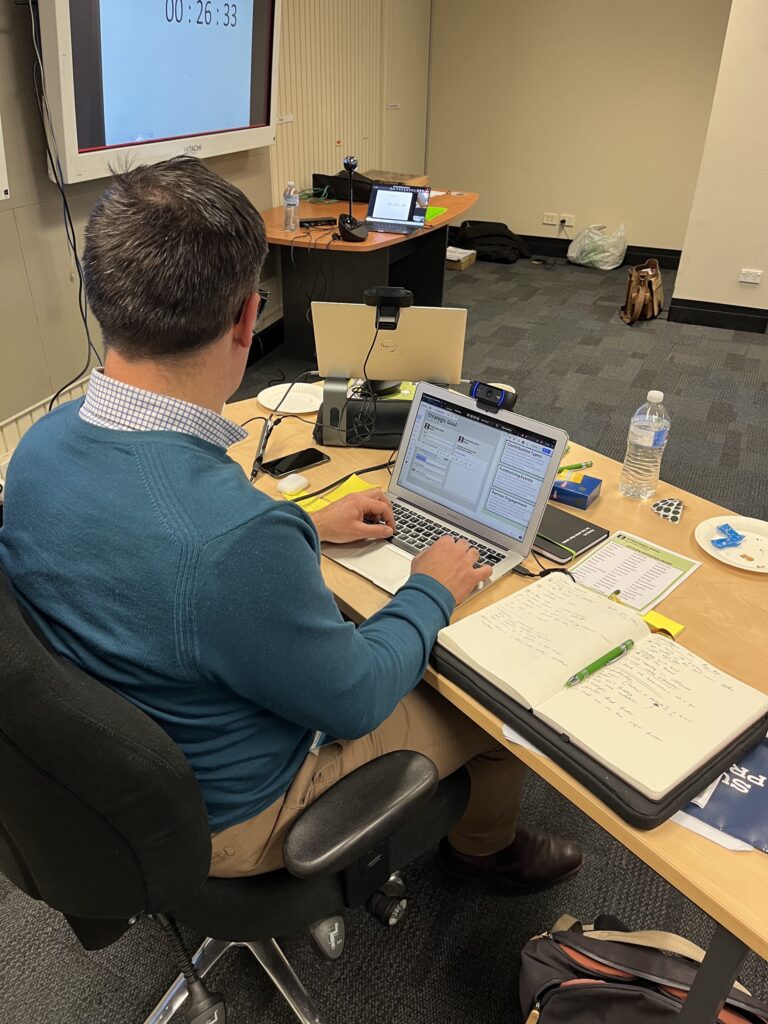5 key takeaways. Lessons Learned from Delivering a Hybrid Workshop.
5 Lessons Learned from Delivering a Hybrid Workshop.
We’ve been delivering hybrid workshops for a while now. We can’t escape it as facilitators! With the ease of joining meetings virtually and working from home, you will most likely encounter people who will ask to participate in your workshop virtually – even though you highly recommended they join in person.
It’s important to be prepared and deliver a good experience for those online.
We took the liberty of writing our 5 lessons learned from delivering these hybrid workshops – relevant for all tech levels, whether you’re using just a laptop and webcam or advanced gear like a Stream Deck and VideoMic.
- Design your workshops for virtual and face-to-face participants alike.
When you’re designing your workshop activities, interactions, agenda and goals, it’s important to remember that your virtual participants need to be able to contribute at the same level as the face-to-face participants.
What should you consider for the workshop design?
Make sure your activities can be replicated on an online whiteboard, like Miro or Mural. This ensures your virtual participants have the same experience and contribution as face-to-face participants.
2. Remember to assess their digital literacy skills.
You may plan your workshop with the assumption that your online participants possess a similar level of digital literacy as you do. This might not be true. Ensure you either engage in a conversation with your virtual participant about their prior experience with online whiteboards or ask them to assess their proficiency in online meetings and computer skills.
3. Have a co-facilitator
If you’re planning to deliver a hybrid workshop by yourself – we would try to convince you otherwise.
As a facilitator you’re dedicating your attention to the participants, the slides, the activities, and making sure that the tech is working, and the virtual participants might slip your mind.
What can a co-facilitator do?
A co-facilitator can help set-up the tech and support the virtual participants. We recommend the co-facilitator be in the virtual meeting and be dedicated to supporting the virtual participant through the activities, especially if their digital literacy is low.

Senior Consultant Tim Hynes assisting the virtual participants
4. Plan and test your tech set-up beforehand.
It’s important to plan what technology you will use before the session, especially if you are running your workshop on a client site and are unfamiliar with their technology.
We recommend first thinking about what experience you want to create for the virtual participants. Will they see the face-to-face participants or just the facilitator? Will they have to view a PowerPoint presentation? You need to have a good idea of what the optimal experience from the virtual participant side needs to be.
Come prepared!
Bring 10 HDMI cables, bring your different cameras, bring different adaptors, different connectors, extension cables, computers, phones…all of it! These days there are many different types of cables and connectors and you don’t want to be caught off guard when the client site has a TV that you can’t connect to.
Test your set-up beforehand.
Make sure about 1 week from your workshop, you go to the client site and run through the presentation. Even with all the preparation, there are still problems you can’t plan for. You don’t want to spend the first 15 min of the workshop troubleshooting why there is an echo on the virtual meeting audio, or why the presentation can’t be displayed.
5. Make your virtual participants visible during the workshop
This is particularly important, especially when the number of virtual participants is significantly lower than those physically present. As the saying goes, ‘Out of sight, out of mind.’ This can occur if you don’t keep your virtual participants visible on screen throughout the session, making it easy to overlook their presence and inadvertently discourage their active involvement in workshop discussions.
To prevent this, ensure that they feel acknowledged, and their active participation will be rewarding for everyone involved.

Need Assistance with Your Next Workshop? If you’re looking for guidance to ensure your next workshop runs smoothly, let’s chat. We’re here to help you succeed!
Did you enjoy this article? Explore more topics on our Experience page.
